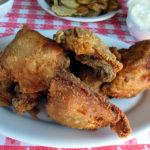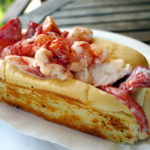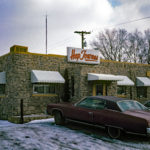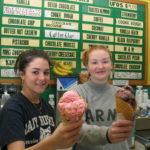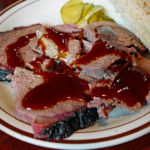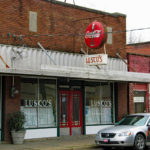Chicken Riddle
THIS IS A STORY about getting lost and eating chicken. When you drive around western North Carolina, it is good to do both. For those of us accustomed to ordinary roads laid out with logic, traveling this part of the world can be mind-bending. It is a mysterious terrain of low blue clouds and mists that hug the hilltops, where people live in hidden hollers and where capillary roads thread past ancient wood cabins in the forest. Five hundred years ago, travelers would have said dragons live here. Today, even the spillover from corporate Winston-Salem, the lure of Dollywood, and traffic to the bustling discount furniture malls of Hickory and High Point have scarcely affected the landscape.
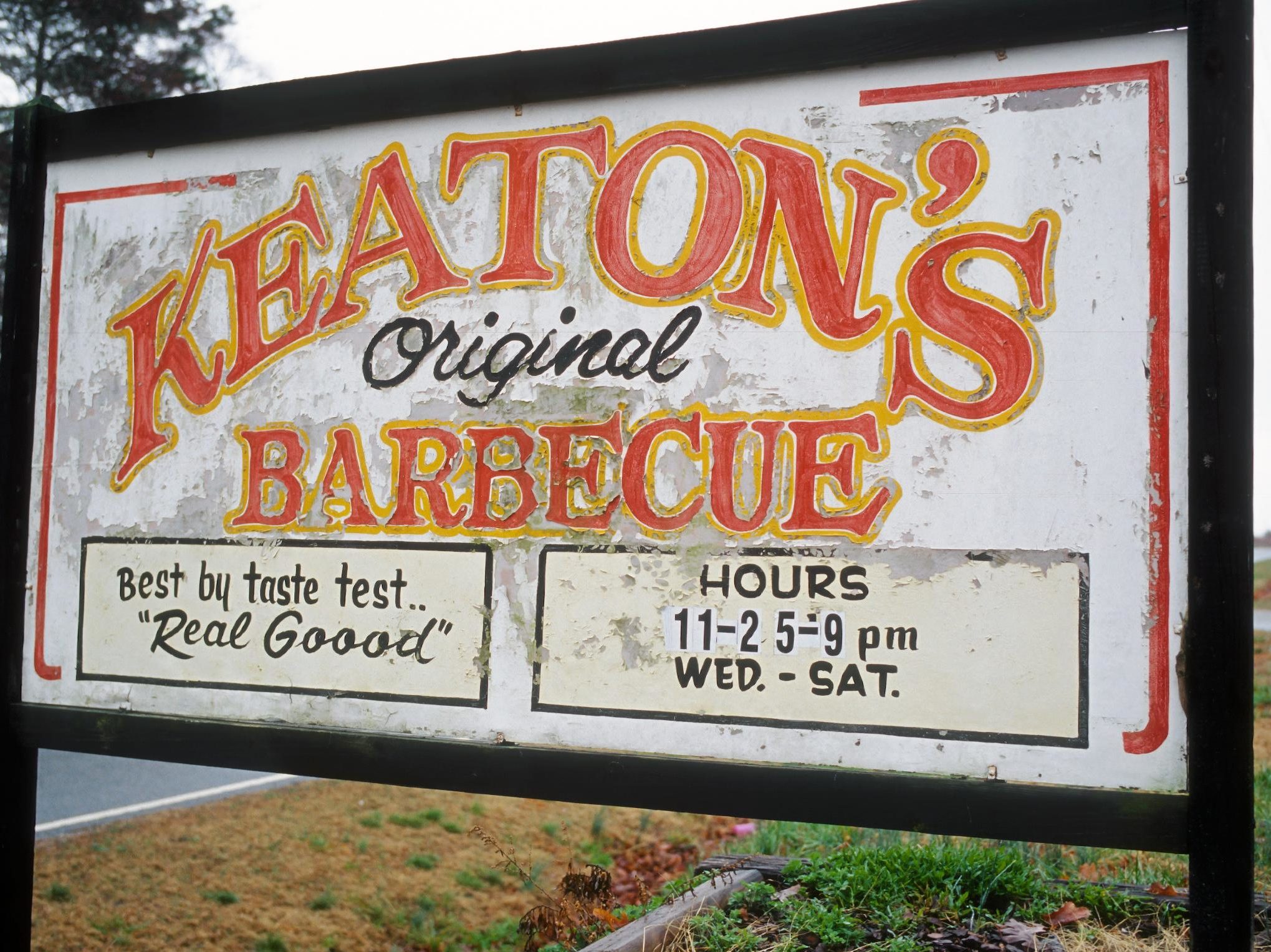
By Jane and Michael Stern
Originally Published 2002 Gourmet Magazine
THIS IS A STORY about getting lost and eating chicken. When you drive around western North Carolina, it is good to do both.
For those of us accustomed to ordinary roads laid out with logic, traveling this part of the world can be mind-bending. It is a mysterious terrain of low blue clouds and mists that hug the hilltops, where people live in hidden hollers and where capillary roads thread past ancient wood cabins in the forest. Five hundred years ago, travelers would have said dragons live here. Today, even the spillover from corporate Winston-Salem, the lure of Dollywood, and traffic to the bustling discount furniture malls of Hickory and High Point have scarcely affected the landscape.
In these parts, extreme seclusion is a hallmark of the best places to eat. There is no such thing as an easy way to get anywhere worthwhile; driving directions to restaurants inevitably include rights and lefts at bent trees and abandoned smokehouses, as well as long climbs up ever-narrowing unmarked roads.
And so, 650 miles from home, we are in a familiar High Country state of being—profoundly lost and profoundly hungry. As the road twists among the hills, we drive past log homes with dilapidated recliners on their front porches, a man in overalls actually working his fields with a hand-pushed tiller, and signs nailed to tree trunks advertising a service that pads church pews.
Our goal is east of the mountains: Keaton’s, a restaurant that appeared out of our good-eats tip file like the ace of hearts rising to the top of a magician’s deck of cards. Recommended in a note from a reader, Keaton’s food was described as “different than any chicken you’ve ever had … so good it almost makes you cry.” The writer’s passion was irresistible. We want chicken worth weeping over! With a box of Kleenex on the backseat and pockets packed with handkerchiefs, we were on our way.
Despite Rand McNally and MapQuest printouts and specific directions we acquire by calling Keaton’s in advance, we find ourselves utterly disoriented as we veer off Highway 64 east of Statesville onto Woodleaf Road, miles from the interstate, past cattle farms and alongside wide open fields. And then we see a weather-beaten sign pointing to a dreary tan cinder-block building that boasts “Best Test by Taste Test.” Okay by us; we like anything scientific.
Another sign says “Original Barbecue.” But we smell no smoke. Slow-smoldering hickory wood is fundamental to barbecue in North Carolina, and its haze customarily envelops barbecue restaurants with a sweet aroma. But there is no pit in evidence here.
There are, however, a lot of house rules. Keaton’s is big on telling customers how to behave. An electric banner-light display on the wall flashes “No Profanity … Keep Noise to a Minimum.” Behind the counter, a large, handwritten sign says, “If Your Waiter or Waitress Takes Your Order and Gives You a Booth or Table Number and You Move and Don’t Tell Anyone, There Will be a Delay in Your Food Order.” We learn, furthermore, that no customer is allowed more than two beers or ten “uppers” (chicken breasts) per visit.
We stand up straight and slick back our unruly hair with wet palms. We enunciate politely to the lady behind the counter, giving her two orders that echo the one placed by the regular customer ahead of us in line, a strapping man who could have been the prototype for the folk song “John Henry.” We ask for a pair of half chickens, “dipped,” with sides of macaroni and cheese, baked beans, hot (i.e., spicy) coleslaw, and sweet iced tea.
We are given a table number and pointed toward the corresponding booth. We sit down, don’t move, and try hard not to use profanity.
IN LESS THAN FIVE MINUTES, a waitress appears with two trays. She sets the food before us. Each meal is plated on Styrofoam and draped with a sheet of translucent Cut-Rite—an ingenious country variant of the glass dome that intensifies the intoxicating aroma of Cognac-infused pheasant. Here, when the wax paper is lifted, the sharp tang of barbecue sauce provides the olfactory rush. We have never seen chicken quite so pretty, glistening with a caramelized glaze that is crusty but not brittle, encasing meat that vents a savory steam when the surface is fractured.
The glaze is what makes Keaton’s recipe unique. The pieces are peppered and salted, floured and pan fried, at which point they are simply excellent country-style chicken. Then comes the “dip,” the distinctive extra step developed by the late B.W. Keaton in 1953: Just-fried chicken is immersed in a bubbling vat of red sauce, a high-spiced, opaque potion similar to the one that graces High Country barbecued pork. The process takes only seconds, but the throbbing sauce permeates to the bone, making every shred of meat an exclamation point. You must eat it with your hands, pulling off crisp strips of sauce-glazed skin, worrying every joint to suck out all the flavor you possibly can. Each table is set not only with a fully loaded napkin dispenser, but with a stack of paper towels as well.
Dining amenities at Keaton’s are picnic-primitive, and decor is minimal. The most interesting thing hanging on the paneled walls is a picture of the late Mr. Keaton, who looks to us like the culinary cognate of bluesman Muddy Waters. Dishes, cups, and flatware are disposable. Cornbread muffins, dinner rolls, and slices of homemade red velvet cake arrive in plastic wrap. All such rituals, like the formal rules of service in this back roads chicken shack, make sense once you taste the food. Strict policies of civilized conduct are necessary to maintain order in a place where the natural result of eating the chicken is a dining room spirit of jubilation verging on anarchy.
Discuss
What do you think of Chicken Riddle?
Related Articles
Stroud’s
By Jane and Michael Stern Originally Published 1995 Gourmet Magazine Chicken...
The Lobster Roll Honor Roll
Maine is the only state in America that features a picture of cooked food on its license...
Meat-And-Three
A few years back, country singer Ray Stevens invited a New York friend to join him at one of...
Top 12 favorite Ice Cream Scoops
WITH THE EXCEPTION of the hot dog bun, there has never been an edible invention as...
Top 5 BBQ Restaurants | Western Kentucky
Get yourself to Western Kentucky for great BBQ I see the food shows on TV where...
Best restaurants in Greenwood, MS | Hot Licks Delta Style
Ever since we first ate margarine-sauced pompano at Lusco’s, in Greenwood,...

